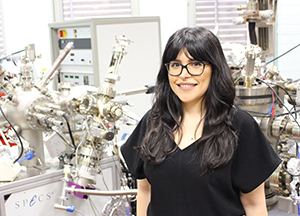
Golrokh Akhgar, Research Fellow, RMIT
Amorphous materials have recently been theoretically predicted to have topologically protected states [1,2]. These results are contrary to the well understood mechanisms that topological states originate from a material’s electronic band structure which requires certain symmetries to be present. Additionally, amorphous materials often allow for the synthesis of non-equilibrium compositions or doping concentrations that are not accessible in crystalline systems. In this talk, we explore the transport properties of disordered Bi2Te3 thin films by performing temperature dependent magnetotransport measurements. Transport measurements in this work demonstrate weak anti-localization (WAL) which illustrates the spin and phase coherence properties in disordered systems. These results might imply the existence of a Berry curvature which is a property of topological order states. Topologically protected states are an aspect of crystalline order in a material’s electronic band structure yet these results appear to indicate topological states in disordered Bi2Te3 thin films.
[1.] Agarwala, et al. Topological insulators in amorphous systems. Phys. Rev. Lett., 118:236402, Jun 2017. [2.] Costa, et al. “Toward Realistic Amorphous Topological Insulators.” Nano letters 19.12 (2019): 8941-8946.About the presenter
Golrokh Akhgar is a postdoctoral researcher at Monash University, with research experience in the spin properties of two-dimensional, surface-conducting diamonds. A. During her PhD, she has gained extensive experience in transport measurements using various low-temperature measurement systems. At FLEET, Golrokh grows Magnetic topological insulators using MBE technique and using them to fabricate and measure various low-energy devices. Golrokh works within FLEET’s Research theme 1 topological materials, Enabling technology A: exciton superfluids and Enabling technology B: nanodevice fabrication in Professor Michael Fuhrer and Dr Mark Edmonds’ Groups.
